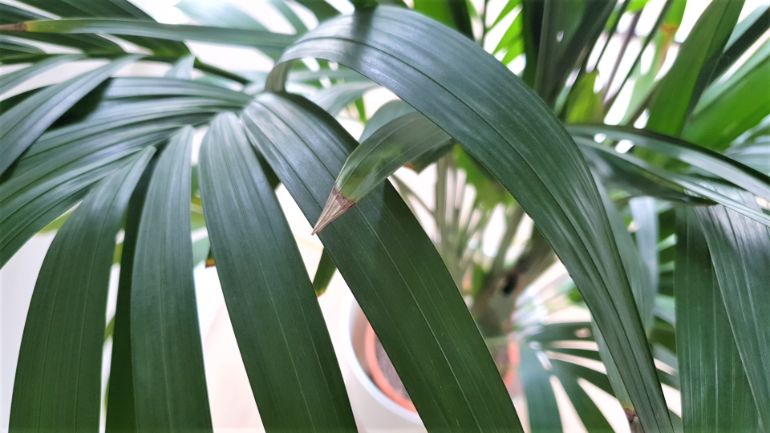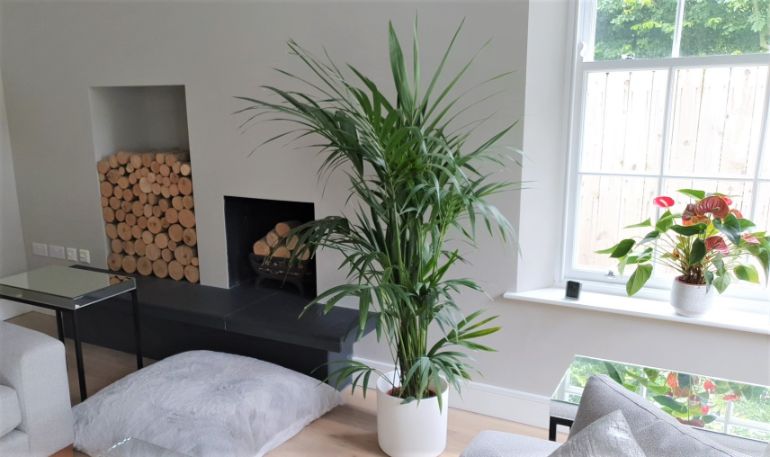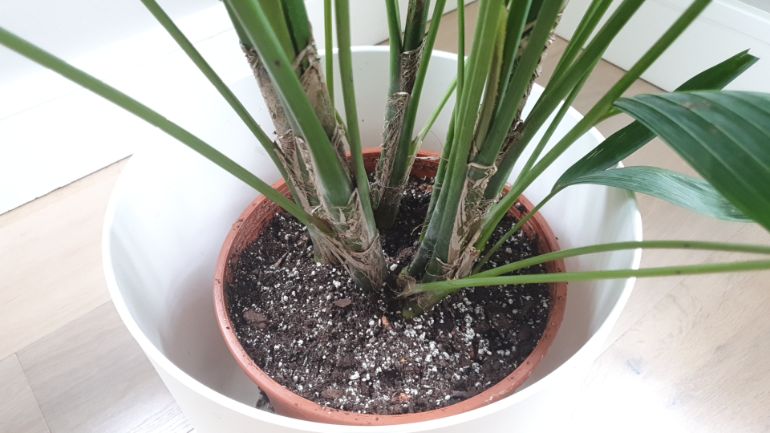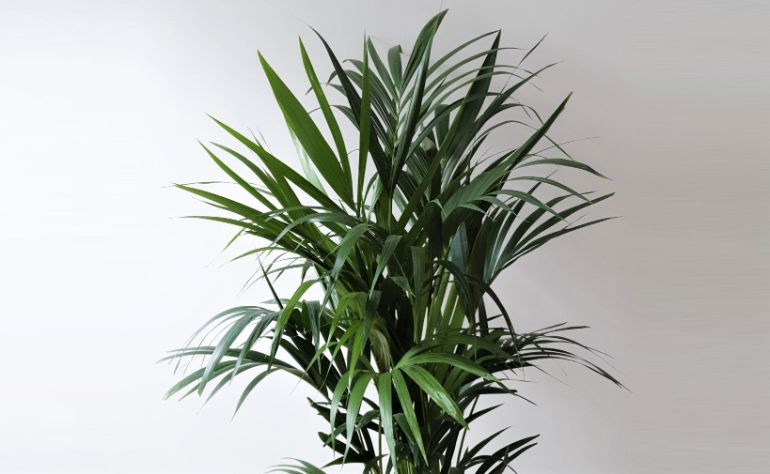With their broad, deep-green fronds and impressive growth habit, Kentia Palms make wonderful statement plants in any home. Whilst generally well suited to being grown indoors, you will need to pay attention to their needs to keep them looking their best. This article covers the most common Kentia Palm problems and how to fix and prevent them.
Overwatering is the most common Kentia Palm problem, but incorrect lighting is close behind. Both can result in your plant becoming progressively more unwell. Yellowing fronds or leaf spotting are almost always a sign of a problem and should be addressed as soon as possible.
What Is Wrong With My Kentia Palm?
Your Kentia Palm (Howea forsteriana) no doubt looked fabulous when you first brought it home, but it’s not easy to keep one looking great unless you provide great care conditions and are attentive to your plant’s needs.
To determine what is wrong with your plant, you need to check your plant closely, take note of all the symptoms it is displaying, and also consider the growing conditions. Once you gather all this information, the cause of the problem usually becomes clear, and you can take important steps to fix your plant.
I’m going to walk you through the process of exactly how to fix each of the common Kentia Palm problems you may encounter, to help you get your plant looking wonderful again. I’m going to cover the following issues;
- Reasons why Kentia Palm leaves turn brown or develop brown leaf tips
- Causes of yellow leaves on your Kentia Palm
- Reasons why your Kentia Palm is drooping
- How to identify pest problems early and fix and prevent them
- Overwatering – Identifying, preventing and fixing this really common issue
- Underwatering – How to recognisze and prevent it
- Incorrect Lighting
Kentia Palm Leaves Turning Brown
Entire leaflets or fronds turning brown can be a sign of multiple Kentia Palm problems, unless it is only happening to one frond at a time. Older fronds will eventually turn brown and die, as they are replaced by new growth. This tends to happen over the space of a few weeks, with progressive browning that affects only one frond. This is considered normal and shouldn’t be a cause for concern.
If the browning is more widespread, or if your Kentia Palm is getting brown spots, you should look closely for signs of a problem.
Causes Of Brown Kentia Palm Leaves
- Excessive Direct Sunlight – Excess light can cause patchy leaf browning and brown tips, affecting leaves that are most exposed to the strong sunlight. Kentia Palms that are grown indoors become accustomed to the lower lighting conditions of indoor spaces, and when they are exposed to strong direct sunlight, they struggle to cope, resulting in leaf scorching. Make sure to position your Kentia Palm somewhere that gets bright, indirect light. A little direct sunlight in the early morning or late afternoon is normally fine.
- Overfertilizing – Excessive fertilizer can cause direct damage to the fronds, resulting in brown patches and tips on the leaflets. Kentia Palms don’t need a lot of fertilizer, and overdoing things can really damage your plant. I fertilize mine monthly during spring and summer with a balanced, half-strength, water-soluble fertilizer.
- Potassium Deficiency – This can cause patchy brown or orange spots on the leaflets of Kentia Palms. It can also present as browning of the tips or peripheral regions of the leaflets. If your Kentia Palm has never been fertilized, consider nutrient deficiency as a potential cause. Read more about the options for fertilizing your Kentia Palm here.
- Diseases – Although Kentia Palms aren’t particularly susceptible to diseases, they can occasionally develop fungal leaf spot diseases such as Cylindrocladium, Stigmina leaf spot. Most diseases cause irregular brown or black spots on Kentia Palm leaves. It is important to quarantine your plant and prune all affected foliage to prevent spread.
- Watering Problems – Both underwatering and overwatering can cause leaf browning. This usually affects the tips first, but can spread to larger regions of the plant. An overwatered Kentia Palm can sometimes present with some of the same symptoms as an underwatered plant, including brown tips and drooping. I cover both these issues in more detail later in this article.

Brown Tips On Kentia Palms
I’m going to mention brown tips separately as it is one of the most common Kentia Palm problems, and with all palms grown indoors. It is primarily caused by low humidity, which causes the tips of the leaflets to dry out too quickly and die. I like to monitor humidity with a digital hygrometer and try to maintain humidity above 50%. A little higher still may be required to eliminate all brown tips.
Use a humidity tray, humidifier, or group your plants to boost humidity. You could also consider locating your plant in a bathroom or the kitchen, which tend to be the most humid rooms in your home. I generally don’t recommend misting houseplants, as this has such a short-lived impact on humidity, that it isn’t really worth the effort.
Low humidity isn’t the only cause of brown tips on Kentia Palms. Watch out for excessively high temperatures, underwatering, and even overwatering. You’ll need to look for other clues to work out what is going on.
Kentia Palm Leaves Turning Yellow
Generalized leaf yellowing is a common sign of overwatering, but there are many other issues that can cause yellow leaves.
Overwatering tends to cause entire fronds to progressively turn yellow over time, often starting with older fronds. It’s important to check your plant thoroughly for any signs that it is being overwatered and take prompt action to correct this.
Pests such as spider mites, scale, and mealybugs usually leave patchy yellow spots where they have fed on the leaves. Irregular yellowing should always prompt you to check your plant carefully for any signs of bugs.
Make sure to check both sides of the leaflets and along the stems for any signs of bugs. Scale and mealybugs are easy to spot, but spider mites are really tiny and often overlooked. Look for their wisp-like webs spun between leaflets.
I have noticed that Kentia Palms can also develop generalized yellowing leaves when light conditions are too bright, but not so bright to cause leaf scorching. When light levels are consistently too high, chlorophyll redistributes itself within the leaves, causing them to look less green and often have a slightly yellow appearance.
Causes Of A Kentia Palm Drooping
Kentia Palms have a very upright, and top-heavy growth habit. This can lead to the foliage starting to droop or lean over time. Drooping is also much more likely if a plant is incorrectly potted, or if it is repeatedly over or under watered.
I repotted my large Kentia Palm last year and found that it started to droop shortly after this. Due to the root disruption from repotting, I found that as the soil dried out and contracted away from the base of the stems, that the foliage would droop over a little.
I resolved this by using a number of stakes and gardening twine to hold it in a more upright position until new roots could grow and better anchor the plant in the new pot.
If your Kentia Palm is drooping, check your plant closely for any other symptoms such as yellowing or brown leaf tips and review the care conditions. Drooping is rarely normal, although can be due to a number of minor issues due to the top-heavy growth habit.

Kentia Palm Pests
Pests can cause quite a lot of damage to your Kentia Palm if you don’t spot the problem at a fairly early stage. I normally check my Kentia Palm every time I water it for any signs of problems. Get into the habit of looking at the front and back of the foliage carefully, as picking up a pest problem early is really important.
You’re most likely to find scale, mealybugs, or spider mites on your Kentia Palm. I’ve written a whole article about how to treat and prevent common houseplant pests, so head over to that article if you want more detail.
The first thing to do if you detect pests is to move your Kentia Palm into a different room from your other houseplants. Quarantining it will prevent the pests from spreading to your other plants.
I have a routine for dealing with pests that works well for most plants;
- Manually remove as many of the pests as possible. Use a cloth to wipe them off, or a hose or showerhead to wash them off.
- Spray the entire plant with either isopropyl alcohol, insecticidal soap, or horticultural oil. Use liberally, so that all of the foliage is treated.
- Repeat the treatment process every 3-4 days until you are 100% confident that all the pests are gone.
- Leave the plant in quarantine for a few weeks just to be extra sure, before moving it back to its normal spot.
- Avoid pruning any of the damaged foliage until the plant has been fully treated and is starting to recover. Pruning only adds further stress to an already struggling plant.
Kentia Palm Overwatering
This is easily the most common of all the Kentia Palm problems you may encounter. If your Kentia Palm has generally yellowing fronds and starts to droop or get brown leaf tips, despite being given plenty of water, overwatering is likely to be the cause.
Also, check for an offensive smell coming from the soil, or lack of growth despite all the other care needs being met.
Overwatering is a major problem because leaving your Kentia Palm in soggy soil prevents essential root aeration and can severely damage the roots, or leave them susceptible to disease. Without healthy roots, the plant quickly starts to show signs of stress.
Overwatering is much more likely to happen to indoor plants due to the reduced lighting and airflow indoors that impacts water use and evaporation, and the tendency of indoor gardeners to a bit overenthusiastic with the watering can.
Causes of Kentia Palms Being Overwatered
Overwatering isn’t just about watering too often. It’s caused by a whole range of things that cause soil to dry out too slowly, or become waterlogged. Here are some things that make overwatering much, much more likely.
- Excessively Large Pots – A small plant in a large pot will be surrounded by lots of soil. After watering, the plant cannot possibly use all the water in the soil in a reasonable period of time, so the soil stays soggy for a long time. This inevitably leads to root rot. Consider using a porous pot material to prevent the soil from staying wet for too long.
- Low Lighting – Low light results in your Kentia Palm using less water, and less water evaporates from the soil. The soil stays wet for longer after watering, greatly increasing the risk of root rot. Bright, indirect lighting is essential to keep your Kentia Palm healthy.
- Poor Drainage – Kentia Palms like moist soil, but they hate soggy conditions. If the soil doesn’t drain well, or if the pot has insufficient drainage holes, or if you forget to empty the drip tray after watering, overwatering and root rot are inevitable sooner or later.
- Low Temperatures – If your Kentia Palm is growing in a cool room, water use and evaporation will be reduced, causing soil to stay wet for longer.

How To Fix An Overwatered Kentia Palm
The treatment for overwatering depends how much your plant is suffering. Addressing some of the factors listed above will be sufficient for mild symptoms of overwatering.
However, if you think your plant has root rot, or if it looks particularly unhappy, the best solution is to remove your plant from the pot and inspect the roots for signs of damage. I recommend removing all the old soil, pruning off all rotten roots, and repotting carefully in a new pot, using a well-draining potting mix.
Once root rot sets in, there is a significant chance the plant won’t recover, but you can save your Kentia Palm with prompt action and attentive care. It can take several months for a Kentia Palm to produce new growth after being treated for root rot, so if your plant survives, a little patience is required.
Underwatering
Underwatering can result in brown leaf tips, drooping, and older fronds dying. Kentia Palms like to be watered once the top half of the soil feels dry, and you should thoroughly soak the soil, and let the excess drain fully each time.
It’s not always easy to remember to water houseplants, so setting some kind of reminder, or positioning your plants somewhere you will see them often can help you avoid underwatering them.
Another common cause of underwatering is if you just water your Kentia Palm a little each time. This “sip watering” often leads to the surface, or a small section of the soil getting wet, without delivering sufficient water to the roots. You may think you’re watering your Kentia Palm enough, but the plant may be crying out for a drink.
I cover my process for watering houseplants in the video below.
Incorrect Lighting
Most people assume watering is the most important thing to keep your houseplants thriving, but lighting is even more crucial. Kentia Palms prefer bright, indirect light when grown indoors, and run into problems when lighting is too intense or insufficient.
Check where your Kentia Palm is positioned in your home and assess the light conditions. I normally recommend that a Kentia Palm should be positioned in the brightest spot in your room that doesn’t receive direct sunlight. The light should be intense enough to cast well-defined shadows, without being in direct sunlight.
You can place your Kentia Palm in any room in your home, but you’ll need to take account of the direction the windows face. For those living in the northern hemisphere, north-facing windows receive the least light, and south-facing windows receive the most. Lighting also changes dramatically depending on the prevailing weather and the seasons of the year.
You may have to move your Kentia Palm around your home at different times of the year to maximize lighting in winter, and prevent leaf scorching from strong sunlight in the summer. I keep my favorite Kentia Palm in the corner of a north-east facing room, right next to two windows. However, I normally move it to a south facing-room in winter to maximize lighting during the dull winter days.
Low light can cause a host of Kentia Palm problems – your plant will grow really slowly and will become sparse and sickly over time, becoming much more prone to overwatering and diseases. Excessively bright conditions usually result in leaf scorching or at the very least brown leaf tips that progressively worse over time.
How Can I Stop My Kentia Palm Dying?
Before you take any action, you need to work out what the problem is. I always feel a sense of urgency whenever I see one of my plants struggling, but there is no point in taking action without identifying the problem first, as it could make the situation worse.
Thoroughly inspect your plant, taking note of all the problems you see. Next, read up on how to provide perfect Kentia Palm care and see where you could make a few adjustments.
It’s amazing how quickly you can work out what is going wrong when you put the pieces of the puzzle together. Bear in mind that there may be a number of issues impacting the health of your plant. If you can’t pin the problem down to one issue, simply make a few adjustments to optimize conditions for your plant, and observe your plant for a few weeks to see if things start to improve.
Last Word
Kentia Palms are undoubtedly my favorite indoor palm plants. I generally find them to be a little easier to keep in good health than some other common indoor palms, such as Areca Palms and Parlor Palms. However, most palms do require a bit of effort to keep looking well indoors, so don’t be too downhearted if you encounter a few Kentia Palm problems from time to time.
Often the best way to get better at growing houseplants is to deal with problems as they arise, and there’s nothing more satisfying than nursing a plant back to health.
If you’d like to learn more about how to keep your houseplants thriving, I’ve got loads more articles on this site to help. You might be interested in some of the articles listed below. You can also check out my book, “Houseplants Made Easy“. It covers everything you need to know to grow stunning houseplants that thrive year after year.

